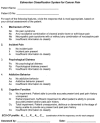Cancer Pain Assessment and Classification
- PMID: 30974857
- PMCID: PMC6521068
- DOI: 10.3390/cancers11040510
Cancer Pain Assessment and Classification
Abstract
More than half of patients affected by cancer experience pain of moderate-to-severe intensity, often in multiple sites, and of different etiologies and underlying mechanisms. The heterogeneity of pain mechanisms is expressed with the fluctuating nature of cancer pain intensity and clinical characteristics. Traditional ways of classifying pain in the cancer population include distinguishing pain etiology, clinical characteristics related to pain and the patient, pathophysiology, and the use of already validated classification systems. Concepts like breakthrough, nociceptive, neuropathic, and mixed pain are very important in the assessment of pain in this population of patients. When dealing with patients affected by cancer pain it is also very important to be familiar to the characteristics of specific pain syndromes that are usually encountered. In this article we review methods presently applied for classifying cancer pain highlighting the importance of an accurate clinical evaluation in providing adequate analgesia to patients.
Keywords: breakthrough pain; cancer pain; neuropathic pain; pain assessment; pain classification; pain syndromes.
Conflict of interest statement
A.C. has received honoraria from Pierre Fabre, Sandoz, Italfarmaco, Molteni, and Ipsen Spa institutional grant. The sponsors had no role in the interpretation or writing of the study. M.SH. declares no conflicts of interest.
Figures
References
-
- World Health Organization . Cancer Pain Relief. World Health Organization; Geneva, Switzerland: 1986.



